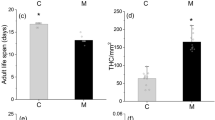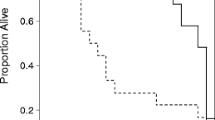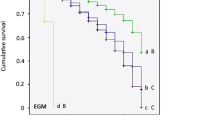Abstract
The present study was undertaken to determine the effects of larval feeding experience on subsequent oviposition behavior of the resulting moths. Larvae of the cabbage looper (Trichoplusia ni, Noctuidae) and the diamondback moth (Plutella xylostella, Plutellidae) were exposed to the phenylpropanoid allelochemical trans-anethole (at 100 ppm fw in artificial diet) or the limonoid allelochemical toosendanin (10 ppm sprayed on cabbage leaves). Both compounds had been shown to deter oviposition in naïve moths in previous choice tests. Moths developing from “experienced” larvae (both sexes) showed a decrease in oviposition deterrence response when given a choice between control and treated leaves, unlike naïve moths. This phenomenon, analogous to habituation to feeding deterrents in lepidopteran larva, occurred irrespective of duration of feeding on the deterrent compound. We also observed that F1larvae resulting from experienced moths (previously exposed to toosendanin as larvae) grew as well on toosendanin-treated foliage as on control foliage. In contrast, growth of F1larvae from naïve moths was significantly impaired by toosendanin. These results demonstrate that host-selection behavior in cabbage looper (a generalist) and diamondback moth (a specialist) may be shaped by feeding experience according to Hopkins' Host Selection Principle in addition to chemical legacy.
Similar content being viewed by others
References
Anderson, P., Hilker, M., and Lofqvist, J. 1995. Larval diet influence on oviposition behavior in Spodoptera littoralis. Entomol. Exp. Appl. 74:71–82.
Barron, A. B. 2001. The life and death of Hopkin's host-selection principle. J. Insect Behav. 14:725–737.
Berenbaum, M. R. and Zangerl, A. R. 1991. Acquisition of a native host plant by an introduced oligophagous herbivore. Oikos 62:153–159.
Bernays, E. A. 1998. The value of being a resource specialist: Behavioral support for a neural hypothesis. Am. Nat. 151:451–464.
Bernays, E. A. and Chapman, R. F. 1994. Effects of experience, pp. 206–229, in A. T. Miller and S. H. Emden (Eds.). Host Plant Selection by Phytophagous Insects. Chapman and Hall, New York.
Bowers, M. D., Stamp, N. E., and Collinge, S. K. 1992. Early stage of host range expansion by a specialist herbivore, Euphydryas phaeton (Nymphalidae). Ecology 73:526–536.
Camara, M. D. 1997. A recent host range expansion in Junonia coenia Hubner (Nymphalidae): Oviposition preference, survival, growth, and chemical defense. Evolution 51:873–884.
Cassidy, M. D. 1978. Development of an induced food plant preference in the Indian stick insect, Carausius morosus. Entomol. Exp. Appl. 24:287–293.
Chen, W., Isman, M. B., and Chiu, S. F. 1995. Antifeedant and growth inhibitory effects of the limonoid toosendanin and Melia toosendan extracts on the variegated cutworm, Peridroma saucia. J. Appl. Entomol. 119:367–370.
Chiu, S. F. 1989. Recent advances in research on botanical insecticides in China, pp. 69–77, in J. T. Arnason, B. J. R. Philogene, and P. Morand (Eds.). Insecticides of Plant Origin. Am. Chem. Soc. Symp. Ser. 387, American Chemical Society, Washington, DC.
Corbet, S. A. 1985. Insect chemosensory responses: A chemical legacy hypothesis. Ecol. Ent. 10:143–153.
Courtney, S. P. 1983. Models of host plant location by butterflies: The effect of search images and searching efficiency. Oecologia 59:317–321.
Craighead, F. C. 1921. Hopkin's host-selection principle as related to certain Cerambycid beetles. J. Agric. Res. 22:189–220.
Cunningham, J. P., Jallow, F. M., Wright, J. D., and Zalucki, M. P. 1998. Learning in host selection in Helicoverpa armigera (Lepidoptera: Noctuidae). Anim. Behav. 55:22–27.
Cunningham, J. P., Zalucki, M. P., and West, S. A. 1999. Learning in Helicoverpa armigera (Lepidoptera: Noctuidae): A new look at the behavior and control of a polyphagous pest. Bull. Entomol. Res. 89:201–207.
Dethier, V. G. 1982. Mechanisms of host-plant recognition. Entomol. Exp. Appl. 31:49–56.
Dimock, M. B., Renwick, J. A. A., Radke, C. D., and Sachdev-Gupta, K. 1991. Chemical constituents of an unacceptable crucifer, Erysimum cheiranthoides, deter feeding by Pieris rapae. J. Chem. Ecol. 17:525–533.
Feeny, P. P., Rosenberry, L., and Carter, M. 1983. Chemical aspects of oviposition behavior in butterflies, pp. 27–76, in S. Ahmad (Ed.). Host-Seeking Behavior and Mechanisms. Academic Press, London.
Futuyama, D. J., Keese, M. C., and Scheffer, S. J. 1993. Genetic constraints and the phylogeny of insect–plant associations—Responses of Ophraella communa (Coleoptera, Chrysomelidae) to host plants of its congeners. Evolution 47:888–905.
Hershberger, W. A. and Smith, M. P. 1967. Conditioning in Drosophila melanogaster. Anim. Behav. 15:259–270.
Hoffman, A. A. 1985. Early adult experience in Drosophila: Comparing apples and oranges. Am. Nat. 126:41–51.
Hopkins, A. D. 1917. A discussion of H.G. Hewitt's paper on “Insect behavior.” J. Econ. Entomol. 10:92–93.
Hovanitz, W. and Chang, V. C. S. 1963. Ovipositional preference tests with Pieris. J. Res. Lepid 2:185–200.
Huang, X. P. and Renwick, J. A. A. 1993. Differential selection of host plants by two Pieris species: The role of oviposition stimulants and deterrents. Entomol. Exp. Appl. 68:59–69.
Hummelbrunner, L. A. and Isman, M. B. 2001. Acute, sublethal, antifeedant, and synergistic effects of monoterpenoid essential oil compounds on the tobacco cutworm, Spodoptera litura. J. Agric. Food Chem. 49:715–720.
Isman, M. B., Koul, O., Luczynski, A., and Laminski, A. 1990. Insecticidal and antifeedant bioactivities of neem oils and their relationship to azadirachtin content. J. Agric. Food Chem. 38:1406–1411.
Isman, M. B. and Rodriguez, E. 1983. Larval growth inhibitors from species of Parhenium (Asteraceae). Phytochemistry 22:2709–2713.
Jaenike, J. 1982. Environmental modification of oviposition behavior in Drosophilla. Am. Nat. 119:784–802.
Jaenike, J. 1983. Induction of host preference in Drosophila mealnogaster. Oecologia 58:320–325.
Jaenike, J. 1990. Host specialization in phytophagous insects. Annu. Rev. Ecol. Syst. 21: 243–273.
Jermy, T., Hanson, F. E., and Dethier, V. G. 1968. Induction of specific food preference on lepidopterous larvae. Entomol. Exp. Appl. 11:211–230.
Kuznetzov, V. I. 1952. The question of adaptation in lepidopterous species to new feeding conditions. Tr. Zool. Inst. Akad. Nauk. SSRR 24:271–322.
Miller, J. R. and Strickler, K. L. 1984. Finding and accepting host plants, pp. 127–155, in W. Bell and R. Carde (Eds.). Chemical Ecology of Insects. Chapman and Hall, London.
Papaj, D. R. 1986. Shifts in foraging behavior by a Battus philenor population field evidence for switching by individual butterflies. Behav. Ecol. Sociobiol. 19:31–39.
Parmesan, C., Singer, M. C., and Harris, I. 1995. Absence of adaptive learning from the oviposition foraging behavior of a checkerpost butterfly. Anim. Behav. 50:161–175.
Prokopy, R. J., Averill, A. L., Cooley, S. S., and Roitberg, C. A. 1982. Associative learning in egg-laying site selection by apple maggot flies. Science 218:76–77.
Rausher, M. D. 1978. Search image for leaf shape in a butterfly. Science 200:1071–1073.
Rausher, M. D. 1980. Host abundance, juvenile survival, and oviposition preference in Battus philenor. Evolution 34:342–355.
Resetarits, W. J. 1996. Oviposition site choice and life history evolution. Am. Zool. 36:205–215.
Rietdorf, K. and Steidle, J. L. M. 2002. Was Hopkins right? Influence for larval and early adult experience on the olfactory response in the granary weevil Sitophilus granarius (Coleoptera, Curculionidae). Physiol. Entomol. 27:223–227.
Singer, M. C. 1986. The definition and measurement of oviposition preference in plant feeding insects, pp. 65–94, in J. R. Miller and T. R. Miller (Eds.). Insect–Plant Interactions. Springer, New York.
Singer, M. C., Thomas, C. D., Billington, H. L., and Parmesan, C. 1989. Variation among conspecific insect populations in the mechanistic basis of diet breadth. Anim. Behav. 37:751–759.
Singer, M. C., Thomas, C. D., Billington, H. L., and Parmesan, C. 1994. Correlates of speed of evolution of host preference in a set of twelve populations of the butterfly Euphydryas editha. Ecoscience 1:107–114.
Smith, M. A. and Cornell, H. V. 1979. Hopkins host-selection in Nasonia vitripenni and its implications for sympatric speciation. Anim. Behav. 27:365–370.
Solarz, L. S. and Newman, M. R. 2001. Variation in hostplant preference and performance by the milfoil weevil, Euhrychiopsis lecontei Dietz. exposed to native and exotic watermilfoils. Oecologia 126:66–75.
Statistix 7. 2000. Analytical Software, Statistix 7 for Windows 95, 98, NT, 2000. Analytical Software, Tallahassea, Florida.
Szentesi, A. and Jermy, T. 1989. The role of experience in host plant choice by phytophagous insects, pp. 39–74, in E. A. Bernays (Ed.). Insect–Plant Ineractions, Vol. 11. CRC Press, Boca Raton, Florida.
Tabashnik, B. E. and Slansky, F., Jr. 1985. Nutritional ecology of forb foliage-chewing insects, pp. 369–391, in F. Slansky, Jr. and J. G. Rodriguez (Eds.). Nutritional Ecology of Insects, Mites, and Spiders. Wiley, New York.
Thompson, J. N. 1986. Constraints on arms races in coevolution. Trends Ecol. Evol. 1:105–107.
Thompson, J. N. 1988. Evolutionary ecology of the relationship between oviposition preference and performance of offspring in phytophagous insects. Entomol. Exp. Appl. 47:3–14.
Thompson, R. F. and Spencer, W. F. 1966. Habituation: A model phenomenon for the study of neuronal substrates of behaviour. Psychol. Rev. 73:16–43.
Thorpe, W. H. 1939. Further studies on pre-imaginal olfactory conditioning in insects. Proc. R. Soc. London Ser. B 127:424–433.
Thorpe, W. H. and Jones, F. G. W. 1937. Olafactory conditioning and its relation to the problem of host selection. Proc. R. Soc. London Ser. B 124:56–81.
Traynier, R. M. M. 1984. Associative learning in the ovipositional behavior of the cabbage butterfly, Pieris rapae. Physiol. Entomol. 9:465–472.
Wiklund, C. 1975. The evolutionary relationship between adult oviposition preferences and larval host plant range in Papilio machaon L. Oecologia 18:185–197.
Zar, J. H. 1984. Biostatistical Analysis, pp. 168–190, Prentice-Hall Inc., Englewood Cliffs, New Jersey.
Zhang, X. and Chiu, S.-F. 1983. The antifeeding and repellent effects of Meliaceous plants to some insect pests. J. South China Agric. Univ. 4:1–7.
Author information
Authors and Affiliations
Corresponding author
Rights and permissions
About this article
Cite this article
Akhtar, Y., Isman, M.B. Larval Exposure to Oviposition Deterrents Alters Subsequent Oviposition Behavior in Generalist, Trichoplusia ni and Specialist, Plutella xylostella Moths. J Chem Ecol 29, 1853–1870 (2003). https://doi.org/10.1023/A:1024802328458
Issue Date:
DOI: https://doi.org/10.1023/A:1024802328458




